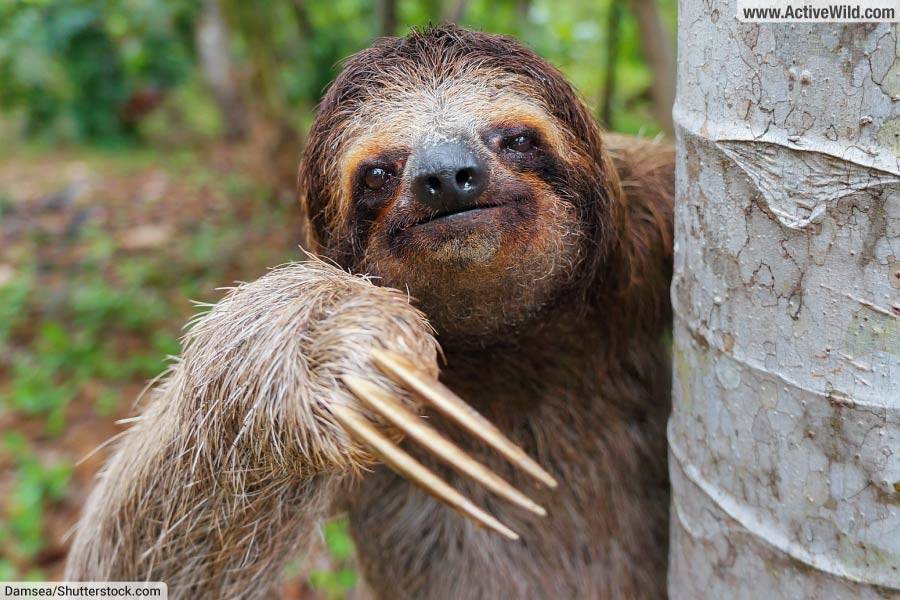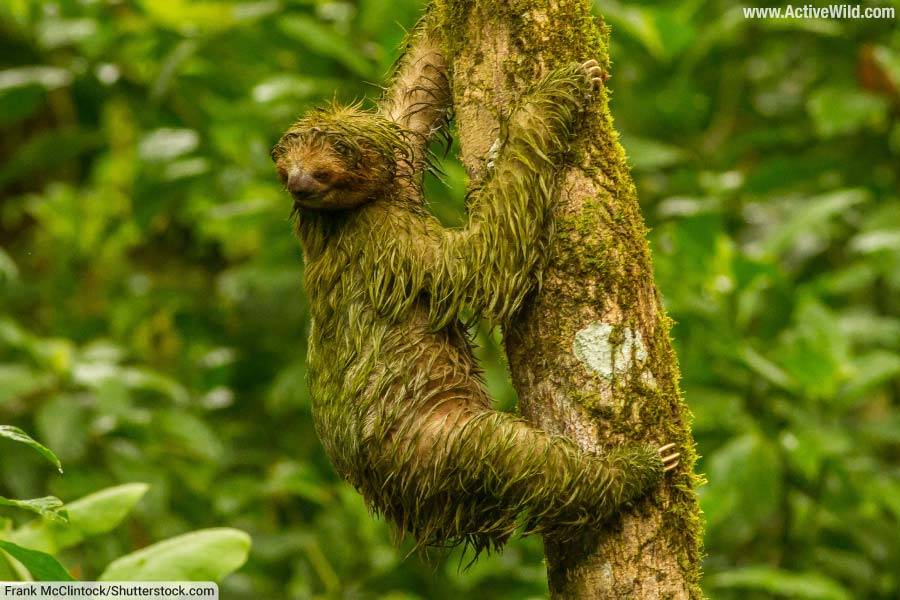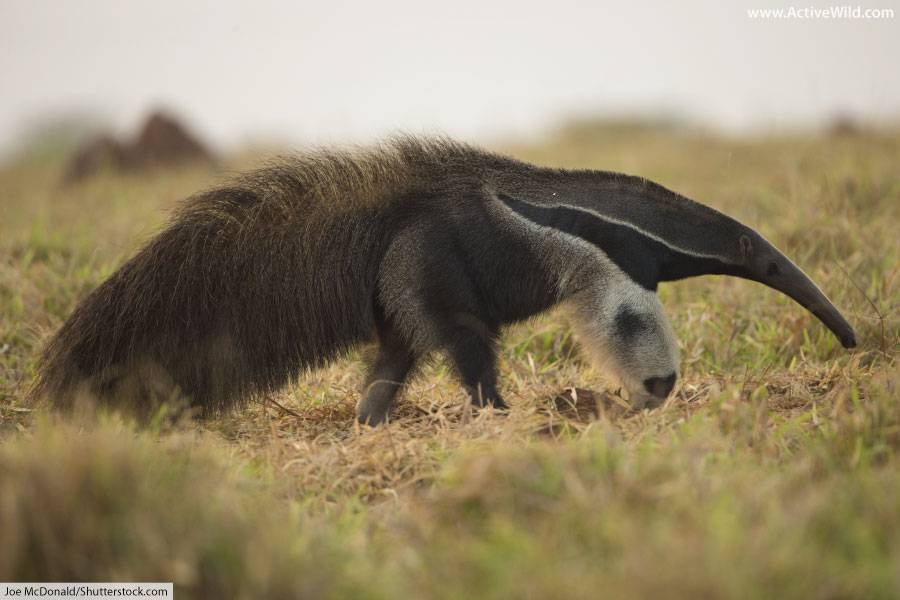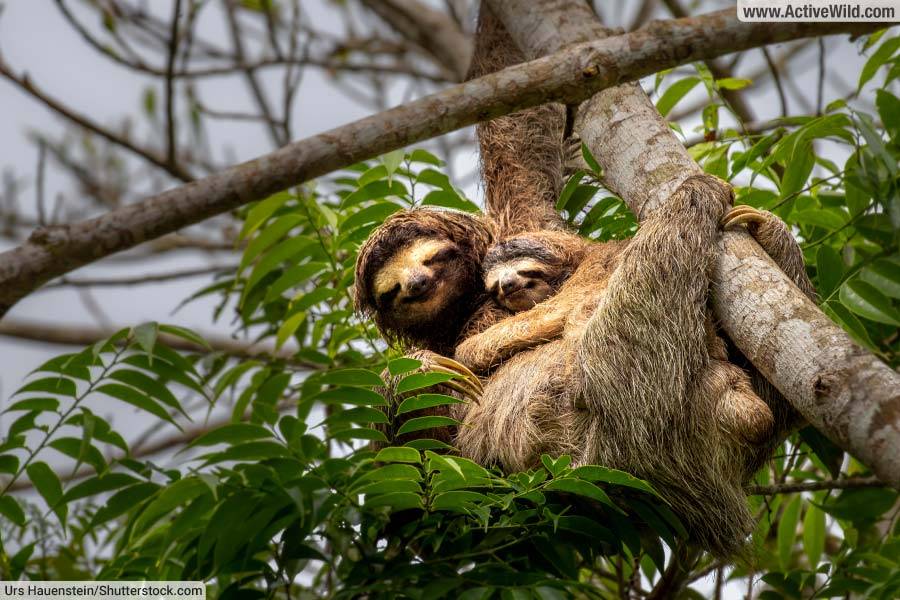
The brown-throated sloth is the most common and widespread species of sloth. Found in the rainforests of Central and South America, this distinctive mammal spends most of its life motionless, hanging upside-down in the rainforest canopy.
Read on to find out more about this distinctive rainforest mammal…
Page Index
- Stats
- Top Brown-Throated Sloth Facts
- What Is A Brown-Throated Sloth?
- Physical Description
- Range
- Diet
- Family And Related Species
- Life Cycle & Lifespan
- Predators
- Conservation Status
- Discover More With Active Wild
Brown-Throated Sloth Stats
- Scientific Name: Bradypus variegatus
- Order: Pilosa (sloths and anteaters)
- Family: Bradypodidae (three-toed sloths)
- Weight: 2.25 to 6.3 kg (5 to 14 lbs)
- Where found: Central and South America
- IUCN conservation status: Least Concern
Top Brown-Throated Sloth Facts
- The brown-throated sloth spends most of its life hanging motionless in the rainforest canopy, only descending from the trees around once every eight days to defecate!
- The sloth’s long, curved claws allow it to hang from branches without expending energy.
- The species is a folivore – a specialized herbivore that primarily eats leaves.
- The brown-throated sloth is the most common and widespread of the six (or seven) sloth species. (For information on every sloth species, see this page: Types of Sloths)
- The species is not endangered, and is currently rated ‘Least Concern’ by the IUCN
- The hair of sloths grows in a different direction to that of most of other mammals – an adaptation that allows rain to run off the animal’s body when it is hanging upside-down.
- The sloth moth Cryptoses choloepi lives in the fur of the brown-throated sloth, and lays its eggs in the sloth’s dung.
- The brown-throated sloth is a “three-toed sloth” – but this group might be better known as “three-fingered” sloths because all sloths – even two-toed sloths – have three toes on their hind limbs. (The groups are named after the number of toes – or fingers – on their fore limbs.)
- The closest relative of the brown-throated sloth is the pale-throated sloth.
- The brown-throated sloth is a surprisingly good swimmer!
What Is A Brown-Throated Sloth?

The brown-throated sloth is a species of three-toed sloth found in the tropical rainforests of Central and South America. Along with the other three-toed sloths, it belongs to the genus Bradypus and the family Bradypodidae.
You can find out about every species of sloth on this page: Types of Sloth
The species has a course, shaggy coat and a noticeable brown coloration on its throat, which contrasts with the rest of its body and distinguishes it from the closely-related pale-throated sloth.
Like all sloths, the brown-throated sloth is almost entirely arboreal (tree-dwelling). It typically only descends from the trees around once every eight days in order to defecate.
The brown-throated sloth’s diet consists mainly of leaves, though it also consumes fruits, flowers, and buds. Due to its limited, low-energy diet, the brown-throated sloth has a very slow metabolic rate, moving only when necessary, and even then, very slowly.
The brown-throated sloth has a number of adaptations that make it well-suited to life hanging in the treetops. Its long limbs are equipped with hooked claws, which allow it to hang from branches while exerting little or no energy. Additionally, the sloth’s hair grows in the opposite direction to that of most mammals, moving from the stomach to the back, which allows water to run off easily during rain while the animal is hanging upside-down.
The brown-throated sloth is solitary and rarely interacts with others of its kind outside of mating periods. It plays an important role in the rainforest as a seed disperser.
Although primarily diurnal (active during the day), the brown-throated sloth may be active at any time during the day or night.
What Does A Brown-Throated Sloth Look Like?

The Brown-Throated Sloth is a medium-sized mammal with a body length ranging from 42 to 80 cm (approximately 16.5 to 31.5 inches) and a weight between 2.25 to 6.3 kg (approximately 5 to 14 lbs).
The coat is coarse and shaggy, predominantly colored in different shades of grey and brown. The most distinguishing feature, as the name suggests, is the brown patch on the throat, which can extend to the face and sometimes around the eyes. The rest of the body may have a mottled appearance, with occasional spots or patches.
The sloth’s fur also hosts a variety of symbiotic algae, which gives some individuals a greenish tinge, further camouflaging them within their leafy surroundings.
Like other three-toed sloths, the brown-throated sloth possesses three long, clawed toes on each limb. This is an adaptation for grasping and hanging from tree branches. The species’ face often has a serene or “smiling” appearance, with small eyes and a short snout.

Where Are Brown-Throated Sloths Found?
The Brown-Throated Sloth is found in forests across Central and South America. Its range extends from the southern parts of Honduras in Central America, through Nicaragua, Costa Rica, and Panama, and spans a significant portion of South America, encompassing countries like Colombia, Venezuela, Ecuador, Peru, Bolivia, Brazil, and northern Argentina.
The species’ preferred habitat is tropical rainforests, but it can also be found in evergreen and secondary forests.
The Brown-Throated Sloth predominantly resides in the canopy layers of these forests, relying on the dense tree cover for both food and protection. Its arboreal lifestyle means it spends the majority of its lives hanging from tree branches, coming down to the ground only infrequently, primarily for defecation or to change trees when necessary.
You can find out more about the canopy and other rainforest layers on this page: Rainforest Layers
Diet: What Does A Brown-Throated Sloth Eat?
The brown-throated sloth is primarily a folivore (a specialized herbivore that feeds on leaves). However, although leaves form the bulk of its diet, the sloth will also eat tender shoots, fruits, flowers, and buds.
Because of the relatively low nutritional value of leaves and the slow metabolic rate of the sloth, the Brown-Throated Sloth has evolved to have a very slow digestion process, allowing it to extract as many nutrients as possible from its food.
Like all sloths, the Brown-Throated Sloth possesses a multi-chambered stomach, similar to that of cows, which helps in the breakdown of the tough cellulose found in leaves.
This specialized digestive system allows sloths to derive maximum nutrients from their limited diet but also contributes to their characteristically slow movements, as digestion requires a considerable amount of energy.
The leaves consumed by the sloth often come from only a select few tree species in any given area, making it a somewhat selective feeder. The limited energy derived from this diet also means that the sloth needs to conserve energy, leading to their well-known languid lifestyle and slow movements.
Brown-Throated Sloth Family And Related Species

You can see every species of sloth on this page: Sloth Species
The brown-throated sloth belongs the order Pilosa, which, as well as being home to all sloths, is also home to anteaters. Animals in this group share similarities in their jaw structures and teeth. Sloths form the suborder Folivora within Pilosa.
Along with the other three-toed sloths, the brown-throated sloth belongs to the family Bradypodidae and the genus Bradypus.
Today, five three-toed sloths are recognized:
- Brown-throated sloth Bradypus variegatus
- Pale-throated sloth Bradypus tridactylus
- Maned sloth Bradypus torquatus
- Pygmy three-toed sloth Bradypus pygmaeus
- Southern maned sloth Bradypus crinitus
(The southern maned sloth has only recently been recognized as being a separate species to the maned sloth, and does not appear on some lists.)
Of these, the pale throated sloth is the closest relative of the brown-throated sloth.
Brown-Throated Sloth Life Cycle & Lifespan

Adult sloths are generally solitary creatures, but they will seek out mates for reproduction. Mating usually occurs during the spring, but varies depending on geographic location. Females are known to produce a scream-like call to attract potential mates.
The male typically leaves after mating, and the female takes on all parenting responsibilities.
The female undergoes a gestation period that lasts about seven months. She will usually give birth to a single offspring, without leaving the trees. The newborn sloth clings to its mother’s belly for nourishment and protection. It feeds on the mother’s milk for around one month. During this period, it gradually gets introduced to leaves.
Once weaned, the young sloth becomes more independent, though it may stay close to its mother for some months or even up to two years.
Brown-throated sloths reach sexual maturity around the age of 3 to 5 years.
Brown-Throated Sloth Lifespan
In the wild, the lifespan of the brown-throated sloth is typically 10 to 15 years. However, in captivity, where threats like predators are eliminated, they can live up to 20 to 30 years.
Brown-Throated Sloth Predators
Known predators of the brown-throated sloth include the jaguar and the harpy eagle.
Is The Brown-Throated Sloth Endangered?
The brown-throated sloth is not endangered, and is currently listed in the IUCN Red List as “Least Concern”. The chief threats to the species include habitat loss and habitat fragmentation. Hunting by local people and illegal trade of live animals also have a negative impact on the species’ population.
Discover More With Active Wild
Visit our main animals page for links to animal information and a complete guide to the animal kingdom: Animals
You can see more rainforest animals on this page: Rainforest Animals List with Pictures & Facts
You can see more South American animals on this page: South American Animals
The post Brown-Throated Sloth Facts, Bradypus Variegatus Species Guide appeared first on Active Wild.